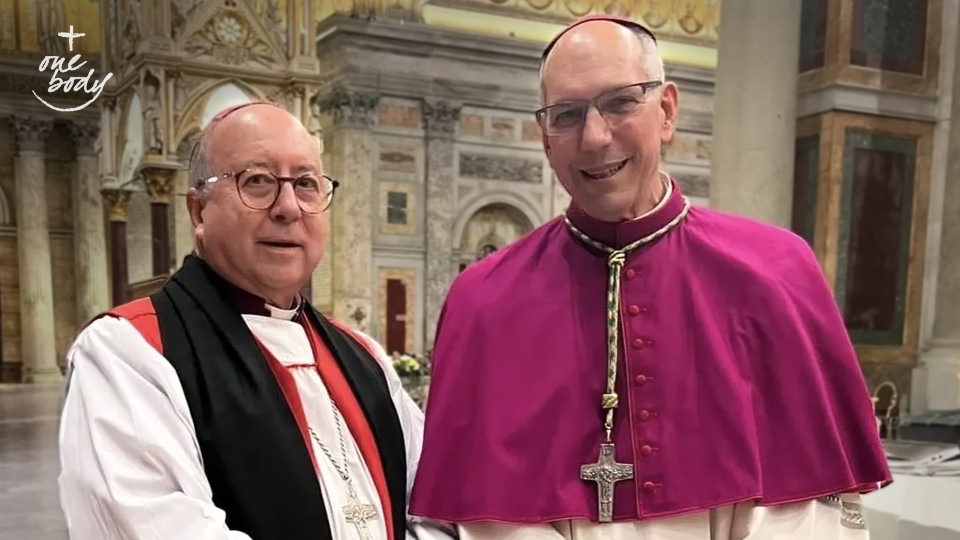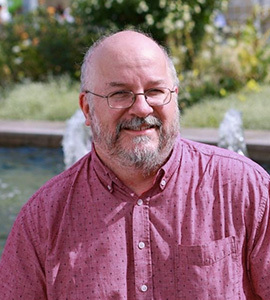

On recognition of ministries and the IARCCUM commissioning | One Body
Nicholas Jesson
Thursday, March 14, 2024

IARCCUM co-chairs Bishop David Hamid, the Church of England's Suffragan bishop in Europe, and Archbishop Donald Bolen, archbishop of Regina, Saskatchewan. Bishop pairs from 27 countries were commissioned by Pope Francis and Archbishop of Canterbury Justin Welby at the Basilica of St Paul Outside the Walls on January 25, 2024. Photo credit: Neil Turner/IARCCUM. Used with permission.

On recognition of ministries and the IARCCUM commissioning
by Nicholas Jesson
On January 25, at the annual ecumenical service in Rome that marks the end of the Week of Prayer for Christian Unity, Pope Francis spontaneously invited Archbishop of Canterbury Justin Welby to offer remarks after Francis’ own homily. Archbishop Justin’s reflection constituted a second homily, though it was called a “discourse” in the Vatican media. Such an invitation had only been offered to Orthodox bishops in the past, so this marked a significant sign of welcome between two leaders who have become close collaborators in a number of projects. On previous occasions, Archbishop Justin and his predecessors had been invited to offer remarks at a later portion of the liturgy, but never immediately after the homily. The ecumenical movement is replete with examples of healthy cooperation between churches, and kind and thoughtful words and actions. These indicate the remarkable trust and respect that has developed between the churches since the 1960s and the Second Vatican Council. However, very little account has been taken of the theological significance of such words and actions. In this blog post, I will point to some potential openings that might be emerging from contemporary Anglican-Catholic relations. Pope Francis and Archbishop Justin began their current ministry just days apart in March 2013. Ever since, they have worked together to draw attention to the needs of refugees and migrants, to address human trafficking and slavery, and to appeal for peace. In February last year, they travelled together to South Sudan with Rev. Iain Greenshields, moderator of the Church of Scotland, to make a special plea for peace amid a bloody civil war. So, it isn’t surprising when Pope Francis greets Archbishop Justin as a friend and publicly addresses him as “my brother.” At the January ecumenical service in Rome, they commissioned 27 pairs of Catholic and Anglican bishops from around the world. Calling the assembled bishops “my brothers and sisters,” Pope Francis said to them:Fourteen centuries ago, Pope Gregory the Great commissioned St. Augustine, first Archbishop of Canterbury, and his companions, to set out from Rome to preach the joy of the Gospel to the peoples of England. Today, with gratitude to God for our sharing in the Gospel, we send you forth, beloved co-workers for the kingdom of God, so that wherever you carry out your ministry, you may together bear witness to the hope that does not deceive and the unity for which our Saviour prayed.Archbishop Justin continued:
God reconciled us to himself through Christ and has given us the ministry of reconciliation. As we send you forth from the tomb of the apostle to the nations, we call on you to make this ministry your special care. As you preach and celebrate the sacraments with God’s holy people, bear witness to the one hope of your calling. May your ministry alongside one another as Catholics and Anglicans be for the world a foretaste of the reconciling of all Christians in the unity of the one and only Church of Christ for which we pray this day.The 27 pairs of bishops were gathered in Rome for a summit of the International Anglican-Roman Catholic Commission for Unity and Mission (IARCCUM), which has been mentioned before in this blog. (As a disclaimer, I should note that I am the editor of the IARCCUM website and archive at iarccum.org.) This summit was the second time the bishops gathered. In 2016, Pope Francis and Archbishop Justin gathered 19 pairs, first in Canterbury to study and pray and then in Rome to continue their pilgrimage to the tombs of the apostles and to be commissioned at the monastery of San Gregorio al Celio. This second time, the commissioning occurred at the Basilica of St. Paul Outside the Walls, above the tomb of the great “apostle to the nations.” As the bishops were sent forth, like Augustine sent by Gregory to be apostle to the English, they continued a mission reaching back to Christ’s own sending of the apostles two-by-two (cf. Mark 6:6-13). Fr. Martin Browne, OSB, the Vatican official responsible for dialogue with Anglicans, reflects on this moment in January by pointing to the ARCIC (Anglican-Roman Catholic International Commission) II document, The Gift of Authority, which states:
For the sake of koinonia [communion] and a united Christian witness to the world, Anglican and Roman Catholic bishops should find ways of cooperating and developing relationships of mutual accountability in their exercise of oversight. At this new stage we have not only to do together whatever we can, but also to be together all that our existing koinonia allows (#58).As Fr. Browne explained in an email:
The commissioning incarnates this in a very vivid way, which renders the whole thing very significant theologically. The Pope and the Archbishop were certainly doing something together in commissioning the pairs. But they were also being something together in the way that The Gift of Authority #58 envisages. They were being together all that their existing koinonia allows. They were being and acting as one. One could argue that in their joint commissioning of the IARCCUM bishops – though it was an act outside the canonical formulae and formularies of either tradition – they were effectively sharing in each other’s episcopal and primatial functions. This wasn’t the Pope commissioning the Catholic bishops and the Archbishop commissioning the Anglican ones, but the two of them commissioning the pairs. This is not just a memorable gesture but is rather revolutionary. Anglican clergy do not normally get commissioned by the Bishop of Rome, and Catholic clergy do not normally get commissioned by the Archbishop of Canterbury, after all!
A real but incomplete communion
Vatican II’s Lumen Gentium, the Dogmatic Constitution on the Church, noted in #8 that the Church of Christ “subsists in the Catholic Church.” As we have explored in this blog in the past, the Council taught that “many elements of sanctification and of truth are found outside of its visible structure.” This has been understood as an affirmation that Christ and the Holy Spirit are active and present in mysterious ways in other Christian communities. Even as the Council was reticent to call these communities “church” in the theological sense, it clearly affirmed that these elements constitute a “real but incomplete communion” with the Catholic Church. Pope John Paul II, in his encyclical Ut Unum Sint, insisted that these ecclesial elements "constitute the objective basis of the communion, albeit imperfect, which exists between them and the Catholic Church. To the extent that these elements are found in other Christian Communities, the one Church of Christ is effectively present in them” (#11). This language of “real but incomplete communion” has provided a basis for substantial ecumenical dialogue and convergence on matters that had previously divided the churches. We have indeed found considerable agreement on doctrinal matters, including baptism, eucharist, justification by faith, Mary and the communion of saints, the church, and various aspects of ministry. However, one problem remains intractable: recognition of sacramental orders. To date, the Catholic Church has not been able to articulate a theological basis for recognizing the sacramental character of ordination in any of the churches of the Reformation or post-Reformation traditions. Thus, a full recognition of these churches has been impossible. Despite various efforts in dialogue, Pope Leo XIII’s 1896 judgement of Anglican orders as “absolutely null and utterly void” remains an impenetrable barrier. A recent statement from the Malines Conversations Group, Sorores in Spe, holds out hope of some further movement in this regard. My bishop and IARCCUM co-chair Archbishop Donald Bolen of Regina, highlighted the ecumenical challenge of recognizing sacramental orders in a keynote address for the 500th anniversary of the Reformation in 2017. He noted that Catholics are able to work closely together with Anglican and other ecumenical partners, cooperation rooted in a nuanced recognition of elements of ministry and sanctification. However, such recognition of the dialogue partner “ought to translate into a positive recognition at least paralleling the ecclesiological recognition communicated in describing our relationship in terms of real but incomplete communion. But when the discussion turns to the validity of orders, we lack a vocabulary and a theological category to introduce that nuance” (“Towards Reconciliation: Recent and Future Steps as we Mark the 500th Anniversary of the Reformation” in Ecumenical Trends 47, no.2, Feb. 2018, p. 1-10).Symbolic gifts
In 1966, just months after the end of Vatican II, the Archbishop of Canterbury, Michael Ramsey, travelled to Rome to visit Pope Paul VI. As they met, the pope removed his own episcopal ring and placed it on the finger of the archbishop. No words were spoken, no explanation given. But, for churches that understand the depth of sacramental signs, the gesture communicated more than was possible in words. In subsequent visits, popes have given gifts of various kinds, always symbolizing a common ministry and spiritual closeness: chalices and patens, stoles, pectoral crosses, Bibles, and prayer books. In January 2016, as Archbishop Justin prepared for a difficult meeting with the Anglican Primates, Pope Francis loaned him the head of the crozier of St. Gregory the Great. Gregory was the pope who sent Augustine to Canterbury in 597 AD, and a crozier is a symbol of episcopal authority. During their meeting, the crozier was placed in the midst of the Primates and reportedly served as a reminder of their common missionary roots. Later that year, Pope Francis gave Archbishop Justin a replica of the crozier that now resides in Canterbury.Effective ministry and affective recognition
Whenever bishops and leaders of other churches visit Rome, they are received as heads of churches. They are seated in places of honour during papal liturgies and addressed by the titles accorded them by their own church. Indeed, no distinction is made between men and women in these roles. After the 2016 IARCCUM Summit, there were some quiet complaints that the Anglicans had not included any female bishops among their complement, although the choice of bishops was probably made in each Anglican province and not centrally. Perhaps some critics thought that the absence was Rome’s doing. Yet, less than a month later, Pope Francis stood together with Archbishop Antje Jackelén of Uppsala at the ecumenical service in Lund to commemorate the 500th anniversary of the Reformation, and together they offered the concluding blessing to the congregation. This year, two women were among the Anglican complement at the IARCCUM Summit: Archbishop Marinez Bassotto, the Primate of Brazil, and Bishop Sally Sue Hernández of Mexico. The increase in number reflects a similar increase in the number of female bishops in the Anglican Communion. Another female Anglican bishop was in Rome just a week later. Bishop Jo Bailey Wells, deputy secretary-general of the Anglican Communion, was invited to speak to the Council of Cardinals about the development of women’s ministries in the Anglican Communion. It should be noted that considerable provisions in the Dicastery for Promoting Christian Unity’s Ecumenical Directory permit the sharing of spiritual activities and resources between Catholics and other Christian partners (#102-142). While noting appropriate limits on sacramental life together, the Directory identifies that the principles for spiritual sharing begin with our common baptism and the “real but incomplete communion” between the churches. In a rarely utilized but significant provision, the Ecumenical Directory authorizes:If priests, ministers or communities not in full communion with the Catholic Church do not have a place or the liturgical objects necessary for celebrating worthily their religious ceremonies, the diocesan Bishop may allow them the use of a church or a Catholic building and also lend them what may be necessary for their services. Under similar circumstances, permission may be given to them for interment or for the celebration of services at Catholic cemeteries (#137).As an example, during the recent IARCCUM Summit, Pope Francis gave permission for Archbishop Justin to celebrate the Eucharist at the ancient church of San Bartolomeo all’Isola, the Sanctuary of the New Martyrs. As a side note: the focus on contemporary martyrs shared between the two churches was particularly poignant as the Anglican and Catholic bishops from the Solomon Islands shared about the seven Anglican martyrs of the Melanesian Brotherhood who are commemorated in San Bartolomeo. According to the ancient axiom, “the blood of martyrs is the seed of the church,” ecumenical work on common martyrology also signifies a growing recognition of one another as church. In addition, the Directory provides for occasions when other Christian ministers are present during Catholic liturgies or for ecumenical worship in Catholic churches. Visiting clergy may wear appropriate vestments: “Where there is a common agreement among the participants, those who have a function in a ceremony may use the dress proper to their ecclesiastical rank and to the nature of the celebration” (#113). “In a Catholic liturgical celebration, ministers of other Churches and ecclesial Communities may have the place and liturgical honours proper to their rank and their role, if this is judged desirable” (#119). In local ecumenical contexts, cooperation and informal recognition are common. In many towns and neighbourhoods, priests participate in local ministerial associations with clergy from a variety of traditions. Bishops routinely meet with other local church leaders and issue public statements with their colleagues. In many cases, these meetings and public statements include churches with whom Catholics might find considerable challenge, yet as we’ve explored throughout this blog series, it is possible to find consensus on matters of shared concern. In my own experience of local ecumenism, I have found that it is invariably true that churches with bishops work well together, and that those governed by councils or committees (a form of collective episcopé) are usually late additions to projects already undertaken. This is not from any animus against non-episcopal churches, but simply because relationships develop more easily between churches when their leaders know one another and can develop personal trust. Bishops frequently operate from a position of affective recognition. Bishops may also have the authority to make commitments on behalf of their community in ways that are slower and more cumbersome for churches that exercise communal discernment. However, as Archbishop Bolen explained in his keynote address in 2017:
I believe that an adequate theological account of ministry in other Christian communities is part of the unfinished work of the [Second Vatican] Council. I trust that the Holy Spirit is leading us in that regard, and it is my fervent prayer that soon we will be able to take some steps towards the recognition of ministry in our Western dialogue partners.Taking the IARCCUM work home Bishop Bruce Myers, the Anglican bishop of Québec, went to the 2024 IARCCUM Summit along with Catholic Bishop Martin Laliberté of Trois-Rivières. Bishop Myers is also the Anglican co-chair of the Anglican-Roman Catholic Dialogue in Canada. Before being elected bishop, he served as the ecumenical officer for the Anglican Church of Canada. I asked him to reflect on the experience. He writes:
The challenge with all such gatherings is how to carry something of this remarkable experience of learning and communion back to the people we serve and serve with — some of whom will be sceptical or cynical about such endeavours. And, for the pairs of bishops, there’s also the challenge of how to sustain the momentum and enthusiasm generated at the summit/pilgrimage now that we’ve returned to the routines and demands of our usual ministries.During the Summit, the pairs of bishops had time to work together to develop concrete ways to move IARCCUM’s vision and work forward in their respective countries and contexts. Among the commitments Bishops Laliberté and Myers have made are:
- “to find ways to present together the experiences and outcomes of the summit/pilgrimage to our respective assemblies/houses of bishops;
- to try to more closely connect IARCCUM’s work with that of the national Anglican-Roman Catholic dialogues in Canada;
- and to promote joint Anglican-Catholic clergy retreats across the country, not to focus on an explicitly ecumenical topic, but rather on a spiritual, biblical, or theological theme on which we already have a common understanding, as a way of witnessing to the substantial unity in faith we already share.”

 Nicholas Jesson is the ecumenical officer for the Archdiocese of Regina. He is currently a member of the Anglican-Roman Catholic Dialogue in Canada and of the Canadian Council of Churches’ Commission on Faith & Witness, editor of the Margaret O’Gara Ecumenical Dialogues Collection, and editor of the Anglican-Roman Catholic Dialogue archive IARCCUM.org. He was ecumenical officer for the Diocese of Saskatoon (1994-99 & 2008-17), executive director of the Prairie Centre for Ecumenism (1994-99), and member of the Roman Catholic-United Church of Canada Dialogue (2012-20).
Nicholas Jesson is the ecumenical officer for the Archdiocese of Regina. He is currently a member of the Anglican-Roman Catholic Dialogue in Canada and of the Canadian Council of Churches’ Commission on Faith & Witness, editor of the Margaret O’Gara Ecumenical Dialogues Collection, and editor of the Anglican-Roman Catholic Dialogue archive IARCCUM.org. He was ecumenical officer for the Diocese of Saskatoon (1994-99 & 2008-17), executive director of the Prairie Centre for Ecumenism (1994-99), and member of the Roman Catholic-United Church of Canada Dialogue (2012-20).Related Articles:
<<












